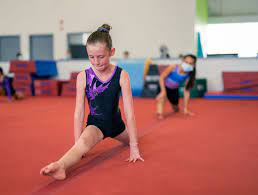Gymnastics for kids builds more than physical strength—it’s a full-body and full-mind workout. This high-energy sport helps children develop balance, coordination, and confidence, while also sharpening focus and emotional control. Backed by research and embraced by parents and teachers alike, gymnastics plays a vital role in children’s growth and wellbeing—both inside and outside the gym.
Below, we explore the top seven physical and mental benefits of gymnastics for kids. These insights can help parents decide if it’s time for their child to try a handstand, a backflip, or simply tumble into better health.
What Are the Physical Benefits of Gymnastics for Kids?
1. Improved Strength and Flexibility
Gymnastics challenges nearly every muscle group. Kids use their arms, legs, and core to support, balance, and propel themselves through various movements. Over time, this builds muscular strength and increases flexibility—especially in the spine, hips, and shoulders.
Greater flexibility can also prevent injury in other sports and everyday activities. Think of it as a lifelong safety net for physical wellbeing.
2. Enhanced Coordination and Balance
One of the key skills kids develop in gymnastics is body awareness. Through activities like beam walking and handstands, children learn how to control their bodies in space.
This translates into improved coordination, balance, and motor skills—fundamentals that help with everything from running and catching a ball to simply moving safely through the playground.
3. Better Posture and Alignment
In gymnastics, kids are constantly reminded to “stand tall” and “tighten their core.” These cues help reinforce correct spinal alignment and muscular control. Long-term, this can reduce the risk of developing poor posture habits—especially important in the digital age where screen time is at an all-time high.
4. Boosted Cardiovascular Fitness
Although gymnastics may not seem like a typical cardio sport, the bursts of explosive movement, sprinting between apparatuses, and circuit-style training contribute to improved heart health. This kind of dynamic activity keeps kids fit, energised, and agile.
How Does Gymnastics Benefit Mental and Emotional Wellbeing?
5. Stronger Focus and Discipline
Gymnastics is as much a mental sport as a physical one. Athletes must pay close attention to timing, technique, and their coach’s instructions. This cultivates strong listening skills, memory, and concentration.
Children who do gymnastics often carry this discipline into school life—demonstrating consistency in routines, better focus in class, and improved time management.
6. Greater Confidence and Resilience
Mastering a cartwheel after weeks of effort? That feeling is powerful. Gymnastics encourages kids to set goals, work hard, and celebrate progress. Each small win builds self-confidence.
Failures—like falling off the beam or missing a skill—are part of the process too. Learning to get back up and try again fosters emotional resilience and a growth mindset.
This aligns with the principle of Consistency, one of Robert Cialdini’s six principles of persuasion. When children commit to showing up regularly, they reinforce their self-image as someone who perseveres. That internal belief becomes self-fulfilling.
7. Improved Social Skills and Teamwork
Although gymnastics is often individual, training sessions and competitions involve strong social elements. Children learn to wait their turn, encourage their peers, and work within a structured environment.
Coaches provide guidance, feedback, and encouragement, modelling respectful communication. Over time, this helps kids become better listeners, more supportive friends, and more comfortable in group settings.
Why Is Gymnastics So Beneficial for Growing Bodies and Minds?
Gymnastics for kids offers a rare combination of physical movement, mental engagement, and emotional growth—all within one activity. Unlike passive screen-based recreation or single-skill sports, gymnastics challenges the whole child.
- Physically, it builds strength, flexibility, and coordination.
- Mentally, it enhances focus, memory, and discipline.
- Emotionally, it boosts confidence, resilience, and social connection.
These are qualities that serve children well throughout their schooling and beyond.
FAQs About Gymnastics for Kids
Is gymnastics safe for young children?
Yes. When practised under the guidance of qualified coaches, gymnastics is safe and age-appropriate. Programs are usually designed to match each child’s developmental stage.
At what age should a child start gymnastics?
Many children begin recreational gymnastics around ages 3–5. However, it’s never too late to start. The sport is highly adaptable to different ages and abilities.
Does gymnastics help with other sports?
Absolutely. The strength, balance, and motor skills learned in gymnastics transfer directly to sports like football, swimming, basketball, and dance.
Conclusion: More Than Just a Sport
Gymnastics for kids is more than flips and floor routines—it’s a foundation for healthy, confident, and well-rounded development. Whether your child dreams of performing at competitions or just wants to play and grow in a fun, active setting, gymnastics offers benefits that go far beyond the gym floor.
For parents curious about gymnastics programs that promote physical health and confidence, there are options designed for every ability level. You might also explore youth sports programs that build strength, coordination, and teamwork in an engaging environment.
To understand more about how physical activity supports brain development in kids, check out this resource from the Australian Institute of Health and Welfare.

